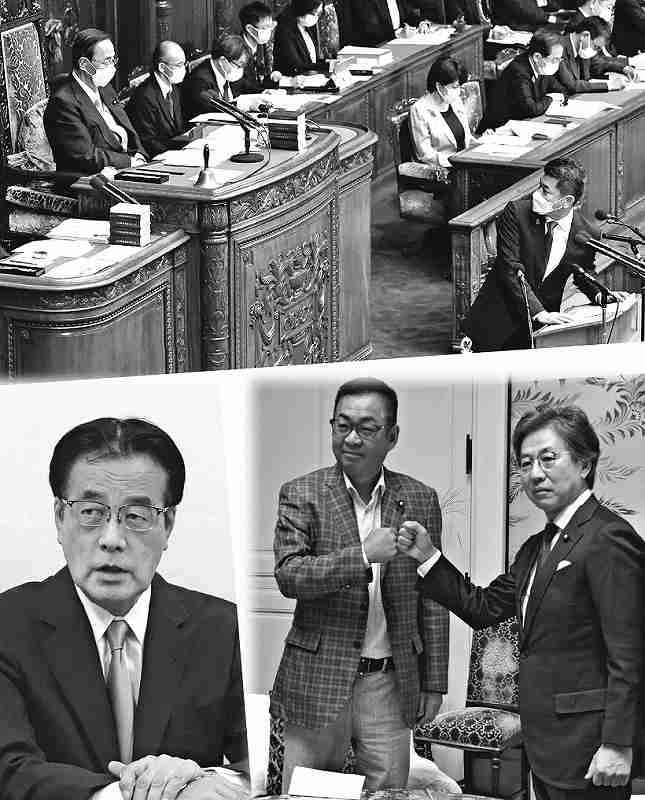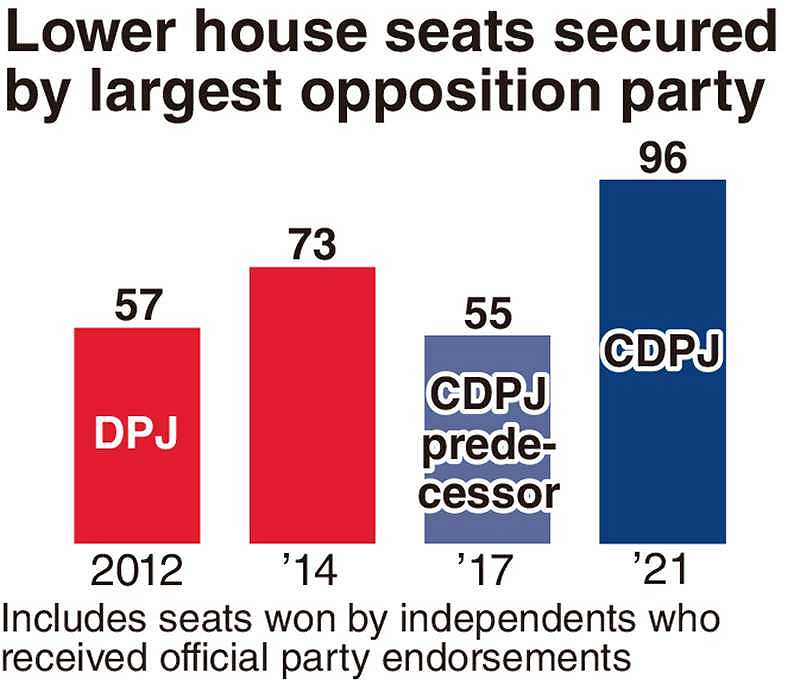Kishida16 / Kishida’s first-year report card / Opposition takes gloves off to garner support

Clockwise from top: Kenta Izumi, the president of the Constitutional Democratic Party of Japan, asks a question to House of Representatives Speaker Hiroyuki Hosoda; left, during a plenary session of the lower house in Tokyo on Oct. 5; Jun Azumi, the chairperson of the CDPJ’s Diet Affairs Committee, right, and Takashi Endo, the head of Nippon Ishin no Kai’s Diet Affairs Committee, bump fists in Tokyo on Sept. 21; CDPJ Secretary General Katsuya Okada
20:00 JST, October 14, 2022
Prime Minister Fumio Kishida’s Cabinet has passed the first anniversary of its inauguration with its approval rating on the decline. This series examines how Kishida’s political style so far has affected the handling of key issues and what the future holds for his administration. This is the final installment of the series.
***
On the morning of Oct. 4, members of the main opposition Constitutional Democratic Party of Japan discussed whether to challenge House of Representatives Speaker Hiroyuki Hosoda, 78, about his alleged links to the Unification Church during a lower house plenary session on the following day.
Discussions intensified between CDPJ President Kenta Izumi, 48, and close aides including Shu Watanabe, 60, head of the CDPJ political affairs office and his deputy Kazuhiko Shigetoku, 51.
Shigetoku and others said the public wanted to hear Hosoda’s explanations, insisting it would not be seen as political grandstanding,
but Izumi was reluctant, worried that the request would be met with uproar in the Diet.
On Oct. 5, party executives were supposed to ask questions related to the policy speech Prime Minister Fumio Kishida had delivered at the start of the extraordinary Diet session earlier in the week.
Even though it is not customary for the speaker to respond to questions in such sessions. the CDPJ members wanted to ask Hosoda who has strong ties to the ruling Liberal Democratic Party about his ties to the group officially known as the Family Federation for World Peace and Unification.
Among CDPJ members, Izumi is known for his dislike of political grandstanding, but he ultimately heeded the advice of his close aides.
Izumi stood at the dais in front of Hosoda during the Oct. 5 question and answer session, and looked back at the speaker seven times, saying, “You should tell the truth.”
Despite the shouting of some lower house members who said this was not the place to ask the speaker questions, Izumi looked directly at Hosoda and repeatedly said, “I’m afraid he does not appear to be able to answer my questions.”
Izumi was in an uncharacteristically combative mood. The CDPJ has made an effort to present proposals in the Diet since Izumi assumed the party leadership last November, but its attempts have proved unsuccessful.
The CDPJ called for temporarily cutting the consumption tax rate to 5% in response to rising prices, but the ruling parties paid no heed to the proposal, which they claimed lacked the backing of financial sources.
The CDPJ suffered a crushing defeat in the House of Councillors election in July, prompting Izumi to adopt a confrontational approach against the ruling parties. The appointment of Jun Azumi, 60, as chairperson of the party’s Diet Affairs Committee was symbolic of this shift.
The now-defunct Democratic Party of Japan (DPJ), a forerunner of the CDPJ, was a force to be reckoned with during the administrations of prime ministers Shinzo Abe, Yasuo Fukuda and Taro Aso from 2007 to 2009.
Azumi honed his political skills as the senior deputy chairperson of the DPJ’s Diet affairs committee when the party toppled the LDP in 2009.
It was Azumi and other CDPJ Diet Affairs Committee members who urged Izumi to challenge Hosoda in the Diet.
Azumi was also behind the CDPJ’s recent agreement with Nippon Ishin no Kai to take a joint stand against the ruling parties on six issues, including a revision of the Public Offices Election Law and measures against so-called spiritual sales tactics used by the Unification Church.
On Sept. 21, Azumi and his Ishin counterpart Takashi Endo, 54, bumped fists in the Diet building after their parties reached an agreement. “We have traded insults before, but if our Diet seats are combined, the number reaches nearly 150,” Azumi said. “We will strive for political change by fighting together.”
For years, the two parties had been at loggerheads with the CDPJ calling Ishin a “complementary force of the administration,” while Ishin criticized the CDPJ for “opposing anything and everything.”
Even though their cooperation is limited to Diet activities and excludes electoral cooperation, the CDPJ’s current approach is in line with Ishin’s intention to hold the Kishida administration in check.
“Azumi’s keen political sense is astonishing as he was able to lead the two parties to form the united front,” a mid-ranking CDPJ member said.
With Azumi as the strong arm of the party and CDPJ Secretary General Katsuya Okada, 69, handling overall party managment, Izumi’s influence could be waning. Nevertheless, there appears to be stability in the party.
It is with the public that the CDPJ is struggling.
The Kishida Cabinet’s approval rating has plummeted from 65% in a poll carried out shortly after the upper house election in July to 45% in a nationwide survey conducted by The Yomiuri Shimbun on Oct. 1-2.
The approval rating for the CDPJ remained unchanged at 5-6% during the same period. Among the survey recipients, the CDPJ is clearly not regarded as a party that can be trusted to run the government.
At a party meeting on Sept. 29, Koichiro Gemba — who has been named foreign and national security minister in a CDPJ shadow cabinet — stressed that the party’s foreign policy “will be refined into one that will earn the trust of the people.”
Toward the end of the year, the CDPJ plans to discuss whether Japan should increase defense spending and possess counterstrike capabilities to destroy enemy missile bases for self-defense.
A key focus will be whether the CDPJ can unite leftists and liberals within the party, who are critical of strengthening defense capabilities, and present security measures that take into account the severe security environment.
The main opposition party will not win public trust unless it comes up with realistic policies in areas that are fundamental to the nation.
On top of security, it needs to present policies on energy supply stability that take into consideration nuclear power, and funding for social security programs centered on consumption tax revenue.

History of disarray
The DPJ won 308 seats in the 2009 lower house election when it took control of the government. However, it lost power in the lower house election in December 2012, with the LDP securing a landslide victory.
Since then, DPJ-linked forces have repeatedly split and united.
When the DPJ disbanded in 2016, many former members joined forces with members of the Japan Innovation Party to launch the Democratic Party. However, the party fell apart ahead of the 2017 lower house election, with some members joining Kibo no To (the Party of Hope) launched by Tokyo Gov. Yuriko Koike, while others joined the Yukio Edano-formed predecessor of the current CDPJ.
As Kibo’s momentum stalled, many of its members subsequently formed the Democratic Party for the People (DPFP).
And in 2020, many members of the predecessor of the CDPJ and the DPFP joined hands to launch a party that ultimately adopted the party name, CDPJ.
At the time of its launch, the CDPJ had more than 100 lower house members, but it secured only 96 seats in the lower house election last October.





